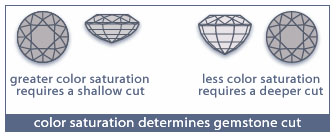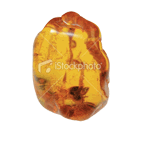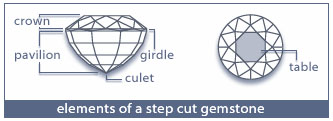Learning more about …
Gemstone Jewelry Guide
 The jewelry industry recognizes the highest quality gemstones by purity of their
hue, the depth of tone, and color saturation. The best values are colors that include
slight traces of other hues, are not too light or too dark, and have a lot of saturated
color
The jewelry industry recognizes the highest quality gemstones by purity of their
hue, the depth of tone, and color saturation. The best values are colors that include
slight traces of other hues, are not too light or too dark, and have a lot of saturated
color
The beautiful color of a gemstone is its most defining characteristic and many jewelers
consider it to be the most important evaluation criterion. When deciding upon a
gemstone's color, pay attention to its hue, tone, and saturation

Properties
Hue
"Hue" refers to the slight variation from the stone's primary color. For example,
sapphires can range in hue from slightly purplish-blue to slightly greenish-blue,
pink sapphires can range from pink to slightly purplish-pink, and rubies can range
from slightly orangish-red to slightly purplish-red
Tone
"Tone" represents the depth of color, ranging from colorless to black. Gemstone
tone is described as "light," "medium-light," "medium," "medium-dark," and "dark."
The most sought-after tones fall within the medium-light to medium-dark range
Saturation
 Saturation, or color purity, refers to the degree to which the gem is free from
brown or gray hues. The most desirable gemstones, which show little gray or brown,
are often described as having "vivid" or "strong" color saturation.
Saturation, or color purity, refers to the degree to which the gem is free from
brown or gray hues. The most desirable gemstones, which show little gray or brown,
are often described as having "vivid" or "strong" color saturation.
Buyer's Tip
In a gemstone with more saturated color, the best cut may be more shallow than average,
permitting more light to penetrate the gemstone, while in a less saturated gem,
the color may benefit from a deeper cut.
Clarity
Identifying marks
Because gemstones form under unique circumstances, each individual gemstone is comprised
of a combination of trace minerals, which create a unique set of identifying marks
or inclusions. Inclusions will not necessarily detract from the beauty or desirability
of a colored gemstone.
What to look for
 When considering a colored gemstone's clarity, you should measure your expectations
against the standard for that variety of gemstone. Some varieties of colored gemstones,
such as aquamarine, blue topaz, and citrine, have naturally fewer inclusions while
other gemstones, such as emerald and ruby, tend to have a higher rate of acceptable
inclusions
When considering a colored gemstone's clarity, you should measure your expectations
against the standard for that variety of gemstone. Some varieties of colored gemstones,
such as aquamarine, blue topaz, and citrine, have naturally fewer inclusions while
other gemstones, such as emerald and ruby, tend to have a higher rate of acceptable
inclusions
Clarity is an important factor in comparing quality colored gemstones. Even opaque
opals can have milky inclusions that will affect their iridescence and color play.
In general, the best values are available in gemstones that are moderately included.
Exceptional gemstones with few or no inclusions are available, but they can command
extravagant prices.
Cut
Colored gemstones are generally cut to maximize the beauty of their color. To recognize
quality in the cut of a gemstone, there are several points to consider.
What to look for
A good cut showcases the gemstone's color, diminishes its inclusions, and exhibits
good overall symmetry and proportion. Because gemstone color can vary, there are
no hard geometrical standards when it comes to maximizing brilliance or color. Gemstones,
especially rarer ones, are sometimes cut for size without regard for their color.
For example, when corundum varieties such as sapphire and ruby are cut for maximum
weight rather than beauty, they may display banded colors or streaks
Gemstone cut
 Look at the gemstone in the setting and ensure that all the facets are symmetrical.
An asymmetrically-cut crown indicates a gemstone of low-quality. In all cases, a
well-cut gemstone is symmetrical and reflects light evenly across the surface and
the polish is smooth, without any nicks or scratches.
Look at the gemstone in the setting and ensure that all the facets are symmetrical.
An asymmetrically-cut crown indicates a gemstone of low-quality. In all cases, a
well-cut gemstone is symmetrical and reflects light evenly across the surface and
the polish is smooth, without any nicks or scratches.
Buyer's Tip
Like diamonds, fine quality colored gems usually have a table, crown, girdle, pavilion,
and culet. Iridescent opals are one exception, and most often have a rounded cabochon
cut.
Size
Different densities
 The carat weight of a gemstone does not necessarily allow you to accurately envision
its size. Different gemstones have different densities (mass per unit volume), so
two gems that appear to be the same size may actually have very different weights.
For example, a ruby is more dense than a diamond, so a 1-carat ruby will look smaller
than a 1-carat diamond.
The carat weight of a gemstone does not necessarily allow you to accurately envision
its size. Different gemstones have different densities (mass per unit volume), so
two gems that appear to be the same size may actually have very different weights.
For example, a ruby is more dense than a diamond, so a 1-carat ruby will look smaller
than a 1-carat diamond.
Buyer's Tip
Always request the dimensions of a gemstone to ensure that the majority of the gemstone
weight will be visible when placed in the setting.
Enhancements
Unpolished gemstones are typically very rough. Gemstones straight from the mine
might be mistaken for pebbles or gravel.
Part of the process
Almost every colored gemstone you will come across has been heat-treated. It is
a common practice around the globe and has been going on for centuries. Heating
completes a process nature started, and is used to enhance the colors of a gemstone.
The jewelry industry recognizes heating as acceptable and expected and part of the
standard polishing and finishing process for many gemstone varieties. The heating
of gemstones is a practice accepted by the American Gem Trade Association (AGTA).
Buyer's Tip
Nearly all gemstones available on the open market have been enhanced. Those that
have not been enhanced are very rare and command extravagant prices. Before buying
a gemstone that has not been enhanced, ask to see a grading report, preferably one
from a well-known gemstone grading lab (like the AGTA). The grading report should
state that the gem shows no indication of enhancement by heat
Care
After removing your gemstone jewelry, wipe it with a soft cloth to remove dirt and
other residues.
In general, all you need to clean your gemstones is warm, soapy water and a very
soft brush. A soft toothbrush and mild dishwashing liquid does a good job. Remove
your jewelry, let it soak in the soapy water for about 20 minutes, and then gently
brush it and rinse thoroughly. Be careful not to scratch the metal of your setting.
Home ultrasonic cleaners are not recommended for all of your colored gemstones.
Ruby and sapphire are typically safe to clean in an ultrasonic cleaner but other
gemstones are not. Because of their porous composition, opals should never be cleaned
in an ultrasonic cleaner. Similarly, emeralds should always be cleaned by hand.
Storing gemstones
Store your gemstone jewelry in a lined case or a soft cloth, so the gems do not
touch each other or parts of other jewelry. Gemstones are harder than gold, silver,
or platinum and can scratch the surfaces of your other fine jewelry if they are
not kept separate.
Wearing gemstone jewelry
While it's true that gemstones such as ruby and sapphire are second only to diamond
on the hardness scale, it is not a measurement of their indestructibility. It means
that these gemstones are able to resist scratching almost as well as diamond. Abrasive
surfaces, harsh chemicals, and sharp blows can damage even the toughest gem. Your
gemstone jewelry should be the last thing you put on when getting dressed and the
first thing you take off at the end of the night. Store it carefully and it will
be enjoyed for generations.